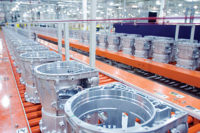Rings that do not seal, porous metals that leak fluid and tubes with holes can result in parts malfunctioning causing millions of dollars in damage, and even loss of life. These are among the many reasons leak testing is a manufacturing necessity. The Lean and 5S implementations have enhanced leak testing processes and facilities. Quality recently caught up with Steven Imp, Quality Manager at Vulcan Global Manufacturing Solutions (GMS) and discussed how Lean and 5S have been further refined since their initial implementation nearly two years ago to make the leak testing process more efficient.
The 5S strategy consists of sort, straighten, sweep, schedule and sustain. The sorting process builds the foundation for the other steps. This building block can be summarized by the phrase “use it or lose it” because anything that is not being used is just clutter and gets in the way.
“If you don’t need it, it needs to go,” said Imp. “Until you straighten the place out, you don’t realize what you have.”
After going through an extensive sorting process, the quality control team at Vulcan GMS identified water pressure testing equipment that was seldom used.
“We did not use it except for a half-a-dozen times, so we got rid of it,” said Imp.
Throwing out equipment that is not used makes the work environment more productive and efficient for those things that are used. Once this process discarding items was approved, the water testing equipment was removed from the room. The company then worked with their customers, whose products were tested using water testing equipment and educated them that Helium testing offered more reliable testing for the same or lower cost. The customers were very pleased.
A designated area for rejected equipment was established and implemented quickly. This prevented parts from accumulating in the work place.
“A Kaizen blitz identified a need to improve our SOP (Standard Operating Procedure) for rejected parts and create a dedicated quarantine area to separate rejected parts from untested and accepted parts,” said Imp.
Vulcan GMS refined their setup fixtures to include universal seal plates, which has resulted in reduced inventory of specific parts. So instead of having a fixture for every part, now a fixture can be used for a family of parts or multiple parts. This processed helped eliminate clutter and decreased the number of set ups.
The consumable products including o-rings, plugs and sealants, have also been standardized and a database created of reorder codes. This information is then placed on part setup sheets and inventory locations. This makes for easy restocking and consistent products since parts are always coming from the same manufacturer.
“We are current finalizing the details to work with our industrial hardware suppliers to have these consumables become a part of a vendor managed inventory where our supplier replenishes our inventory based on a KANBAN system further reducing cost,” said Imp.
According to some Japanese translations, “Kan” means visual and “Ban” means card. This process uses cards as a visual signaling process to trigger the supply process from either an external vendor or from the warehouse. Consumption determines the demand of production. Only what is needed is produced or purchased. This reduces redundancy and waste therefore saves money.
The KANBAN system was developed at Toyota Motor Corporation to enhance a high level production environment.
According to Toyota, these six steps ensure proper KANBAN setup:
- Customer (downstream) processes withdraw items in the precise amounts specified by the KANBAN.
- Supplier (upstream) produces items in the precise amounts and sequences specified by the KANBAN.
- No items are made or moved without a KANBAN.
- A KANBAN should accompany each item, every time.
- Defects and incorrect amounts are never sent to the next downstream process.
- The number of KANBANS is reduced carefully to lower inventories and to reveal problems.
KANBAN is part of Lean and 5S manufacturing. These implementations are dynamic and result in continual refinements.
“Lean and 5S enables creativity. Most of these gains have been a snowball effect from a previous improvement,” said Imp.
One improvement spawns another which makes for a continually efficient and productive manufacturing environment.








